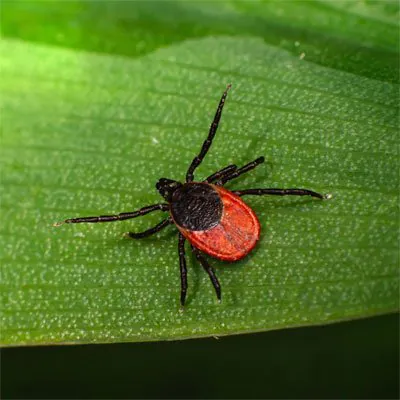Why the arachnids are spreading more and more, why their sting is so dangerous and what measures can be taken to protect against tick bites
Whether in forests, in the undergrowth, near rivers or in parks: ticks can be found almost everywhere in nature. In spring and autumn, between March and November, their occurrence is highest – the arachnids love it warm and humid. In recent years, the occurrence of ticks has increased massively due to increasingly warmer temperatures as a result of climate change. The habitat suitable for ticks in Switzerland increased by around 4,000 square meters between 2009 and 2018 alone. The number of tick bites has also increased by around 40 percent in the last decade. One of the main reasons – in addition to the improved living conditions for the insects: people are spending more time outdoors in nature. Especially due to the corona pandemic, forests and meadows have become popular destinations in the past two years.
But what should nature lovers know about ticks? How do possible Lyme disease or TBE infections manifest themselves after tick bites and what measures can children and adults take to protect themselves effectively outdoors?
Do ticks bite or sting?
The most widespread type of tick in Switzerland is the castor bean tick. The arachnids are particularly active in spring and autumn, they are found on grass and shrubs close to the ground as well as on plants up to about 2 meters above the ground. In all stages of development – from the larva to the nymph to the adult tick – it needs blood. When people and animals roam through nature, the insects infest the body in a suitable place and attach themselves there. Colloquially, it is usually referred to as a tick bite.
Strictly speaking, however, the insects sting their victims to get at the blood. Ticks have a proboscis – with the help of their scissor-like mouthparts they simply tear open the skin of the host, then pierce it with their proboscis and attach themselves.
How quickly does a tick bite become noticeable?
Tick bites often go unnoticed. The reason: There is an anesthetic in the saliva of the tick. Other substances prevent the blood from clotting or the puncture site from becoming inflamed. In extreme cases, the tick can remain on the host for up to 15 days. With a hearty meal, ticks can theoretically survive for up to ten years without any other food. In nature, the common wood tick survives an average of three to five years. An adult female tick needs a blood meal to be able to lay her eggs – up to 3,000. After laying the eggs, the female dies; the male tick dies immediately after mating.
Why do ticks transmit diseases?
The tick filters out the substances that are important for it from the blood and digests them. Unneeded fluid is returned to the host via the proboscis. This process is repeated throughout the suction period – various pathogens can be transmitted here. Around a third of all ticks in Switzerland carry viruses and bacteria. Lyme disease and tick-borne encephalitis (TBE) are typical tick diseases.
What are the first signs of Lyme disease?
Lyme disease (Borreliosis) is one of the most common tick-borne diseases. It is transmitted by Borrelia (Borrelia burgdorferi). The bacteria reside in the gut of the tick. Depending on the area, five to 50 percent of ticks in Switzerland carry the pathogen. A Lyme disease infection often goes unnoticed at first. About three to 30 days after the tick infestation, the bite reddens, so-called erythema and sometimes flu-like symptoms occur. Even a long time after the tick bite, problems in the nervous system or inflammation of the joints can occur in those affected. A blood test can detect Borrelia and the disease can be treated with antibiotics.
How dangerous is a TBE infection?
Another typical tick disease is meningitis (TBE). It is transmitted by viruses in the saliva of the bloodsuckers and thus usually directly after the tick bite. The number of cases has quadrupled in the last eight years – last year there were almost 400 cases. With the exception of a few cantons, all of Switzerland is considered a TBE risk area. Similar to Lyme disease, TBE often goes unnoticed at first. In the second phase after the tick bite, symptoms such as severe headaches, fever, paralysis and impaired consciousness can occur. Severe courses can lead to permanent damage and even death. Meningitis cannot be treated with antibiotics, only the symptoms are alleviated with medication. The TBE vaccination offers reliable protection against illness. In Switzerland, this is recommended by the FOPH for all adults and children over the age of six who live in risk areas or spend some time there.
By the way: In Switzerland, a tick bite is considered an accident. It is the only country in Europe where accident insurance is responsible for tick-borne diseases and their consequences.
How can I protect myself from tick bites?
Especially in the main tick season between March and November, long and well-fitting clothing and a hat should be worn when staying in nature. The small insects are clearly visible on white or beige fabrics and can be shaken off before they attach themselves to the skin. Tick repellents such as sprays and creams also protect against tick bites. In the evening, the entire body should be checked for ticks – preferred places are the back of the knees, armpits and groins, and often the head of children. Since ticks can survive for a few days on clothing indoors, depending on the humidity, clothing should be shaken out carefully and placed in the tumble dryer for at least an hour. The hot temperatures usually kill the bloodsuckers reliably.
Important: Pets in particular, such as dogs, like to bring ticks home with them after long walks in the forest. Their fur should always be checked thoroughly and combed out if necessary.
What is the correct reaction after a tick bite?
If a tick is discovered, it should be removed immediately with tweezers or tick tweezers perpendicular to the skin surface. The region around the puncture site should be marked and carefully observed for some time after the puncture. If there is noticeable reddening of the skin or flu-like symptoms, we recommend contacting your family doctor. The problem: The infections often go unnoticed, and symptoms may only appear weeks, months or even years after a tick bite. If you want to know whether the tick you found carries Borrelia or TBE viruses, you can send it to special laboratories such as Biolytix. It is true that a borreliosis finding in the tick does not automatically mean that the disease will break out in the person who has been bitten. However, such tick tests can make an important contribution to diagnosis and treatment for early detection and sensitization to possible later symptoms of Lyme disease. Since TBE cannot be treated, vaccination against meningitis is the only reliable protection to prevent serious disease progression with sometimes dramatic consequences.




